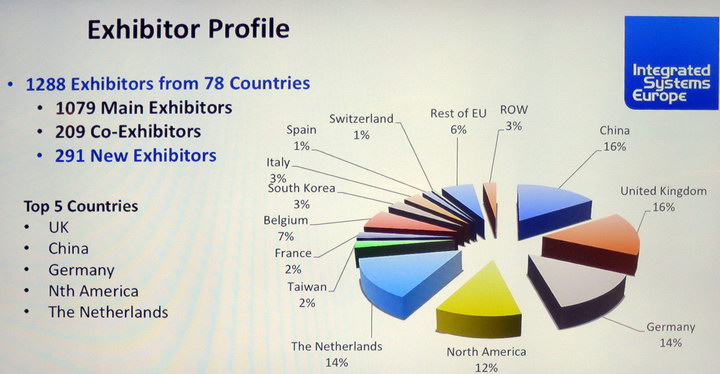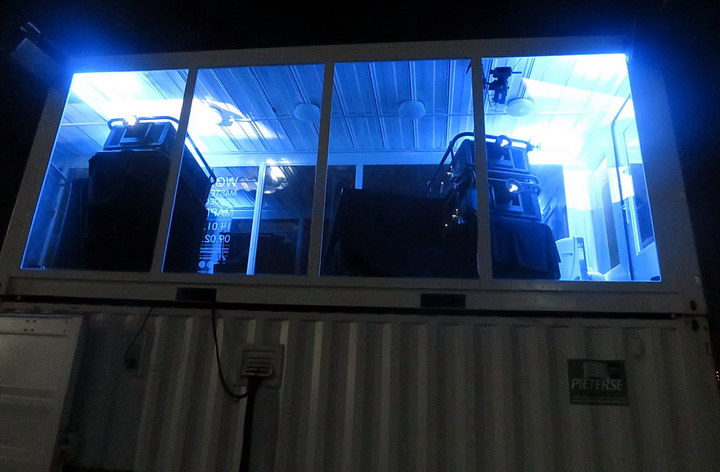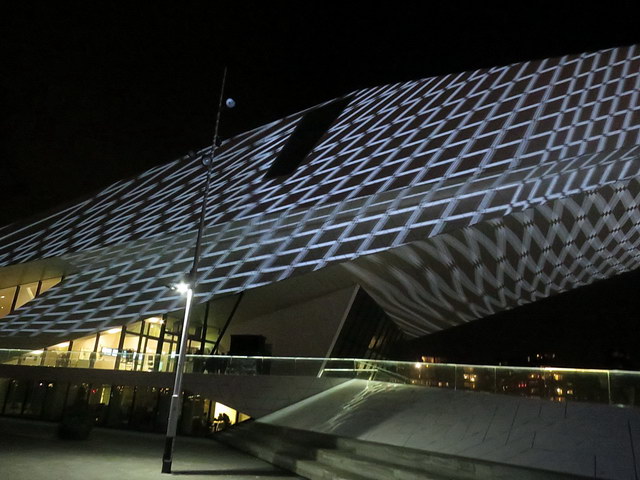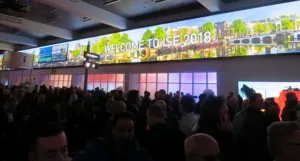
Integrated Systems Europe (ISE 2018) was held in Amsterdam at the RAI center. It’s a big show, a bigger show than InfoComm in the US, which covers similar topics.
According to ISE’s managing director Mike Blackman and his guest, Amsterdam Alderperson Udo Kock, at the press briefing before the opening of the ISE show floor, ISE is Amsterdam’s largest event.
The show is a joint venture of AVIXA (Audiovisual and Integrated Experience Association, formerly known as InfoComm International) and CEDIA (Custom Electronic Design & Installation Association). AVIXA focuses on professional AV and CEDIA focuses more on the installation end of the business, especially home installations and the ISE show has areas of both. Bob Raikes and I attended the show this year and our focus was on the new displays on display, the ones Large Display Monitor readers would be interested in, especially professional displays such as projectors, LED videowalls, flat panel displays and computer monitors.
 ISE’s Mike Blackman with Amsterdam’s Udo Kock. (Credit: M. Brennesholtz)
ISE’s Mike Blackman with Amsterdam’s Udo Kock. (Credit: M. Brennesholtz)
Pre-show Expectations
While ISE has only been in existence for 15 years, it has grown consistently (and we’ve covered all of them!). While the final attendance totals had not been announced as of February 14th, a very happy Mike Blackman announced over the PA system as the show closed at 4:00pm Friday that it had attracted “more than 80,000 attendees”. (This was later confirmed as 80,923, with over 20,000 on the last day) This compares, for example with the 44,000 attendees AVIXA expects for the upcoming InfoComm 2018 to be held in Las Vegas in June.
 ISE Growth 2014 – 2018. The final attendee count for 2018 was over 80,000 (Source: ISE)
ISE Growth 2014 – 2018. The final attendee count for 2018 was over 80,000 (Source: ISE)
Matching the growth in attendee numbers, the floor space of the show has grown consistently since 2014 to a total of 53,302 M2 (573,738 sq. ft.) spread over 15 halls in 2018. This overfills the RAI, the Amsterdam convention center, and ISE sets up two temporary structures, halls 14 and 15. Hall 14 was set up in a RAI courtyard and was new in 2017. This year it was used for, among other things, demonstrating drones. Hall 15 was new for 2018 and was set up on the Europaplein in front of the RAI. It was labeled “The Discovery Zone” and housed a variety of start-ups and small companies, especially companies that were new to ISE.
 Exhibitor Profile for ISE 2018 (Source: ISE)
Exhibitor Profile for ISE 2018 (Source: ISE)
This year at ISE there were expected 1288 exhibitors from 78 countries. This includes 209 co-exhibitors sharing a booth and 291 new exhibitors. Of course, some companies that are nominally European are actually local sales, marketing and support organizations for non-European companies, such as Panasonic Marketing Europe GmbH.
 ISE Attendee Demographics (Source: ISE)
ISE Attendee Demographics (Source: ISE)
As of 7:30 February 6th, just before the press preview of the show, 62% of the registered attendees had been at previous ISEs while for 38%, this was their first show. Broken down another way, 27% of the registered attendees were actually exhibitors 72% were regular attendees and 1% were press. Blackman explained they counted exhibitors as attendees because it was inevitable that the exhibitors would look around the show floor to check out the competition. Attendee breakdown by country is given in the figure, with the top five countries being the UK, China, Germany, North America and the Netherlands. These five countries represented about 72% of all attendees. Blackman said that, overall, about 20% of the attendees came from outside Europe. This trend toward large numbers from the rest of the world is likely to accelerate in the future, with the encouragement of the ISE. After all, they are using the catch-phrase “European destination of the global AV community” in their advertising.
Viewer Experience vs Hardware
Virtually every company I talked to at ISE had a new product to introduce to the European market at the show. If many of them were not strictly new products because they had been previously shown in Asia or North America, at least they had not been shown before at ISE. With the possible exception of the Digital Projection 8K projector (see separate article in this issue), I did not see any new product that appeared to be breakthrough or revolutionary. This is really not too much of a surprise because Integrated Systems Europe primarily targets European system integrators. A system integrator is not really interested in a product that isn’t available yet – he has a customer and he wants to supply an integrated system within the time limits set by the customer. Given a customer deadline, an integrator wants a known product with a known performance, a known delivery date and a known price.
Many AV products are almost commodities at this point. This can be seen in the name change from “InfoComm” to “AVIXA,” which is intended to emphasize the attendee experience over the AV hardware. While the AV hardware may be nearly commodity, the experience it can produce is not, or at least, it should not be a commodity. Hence, the shift in emphasis at AVIXA away from the hardware to the viewer experience the hardware can produce. This shift in emphasis is even visible at some of the hardware manufacturers. I visited several LED video wall manufacturers who would not only sell you modules but would sell you a complete integrated system, including the modules, drivers, controllers and even in some cases content. The new Optoma LED videowall was one example of this integrated approach.
This shift in emphasis from hardware to experience was visible at virtually all the projector makers at ISE. They demonstrated their systems not just as projectors with pretty pictures, but integrated into complete systems, including software and system designs from the projector manufacturers’ partners. These systems were in many cases targeted at retail applications and were similar to ones I saw in January at the National Retail Federation’s Big show. (See LDM Volume 25 No 3 dated January 27, 2018.NRF: Overview of The Big Show). Except in the Elo booth, where they were showing off their point-of-sale terminals and touch screen panels, I did not see any demos at ISE that were identical to the ones I saw at the NRF.
This integration is also visible in the business aspects of the companies exhibiting at ISE. For example, the acquisition by NEC of S[Quadrat], announced at ISE, and the acquisition of Calibre by Coretronic Last August and highlighted at ISE were both justified to me by company reps as providing the acquiring company a broader range of products so they can supply any integrated need.
The Ribbon
Attendees waiting in the main lobby under the ribbon for the 10:00 Tuesday opening of the exhibition. (Credit: M. Brennesholtz)
In the main lobby for ISE of the RAI, there has been a long ribbon over the entrance doors for some years. In 2017, this ribbon was an LED display, a disappointment but not a surprise to a projector person like me who had admired the previous projection-blended ribbon. To my delight, the 2018 ribbon was again blended projectors. The total screen area of the ribbon was 45.7M x 2.70M (150’ x 9’) and the resolution was 17,280 x 1200 pixels on-screen. Lang AG, the European rental house, supplied ten Panasonic PT-RZ21K laser/phosphor projectors, each with 20,000 lumens output and WUXGA (1920 x 1200) resolution, which were edge-blended into the single image.
The screen assembly was provided by AV Stumpfl using gain 1.2 Diamond screen material from Screenline. A single AV Stumpfl Wings Engine RAW was used as the media player to drive all 10 projectors. I was told by Fabian Stumpfl, Managing Director of AV Stumpfl and Hans Christian Stuken, Global Marketing Manager, that a single RAW media player could drive an 8K x 4K display at 60 FPS or drive a 8K x 2K display at 120FPS. The one driving the ribbon and several in the AV Stumpfl booth were not the only Wings Engines at ISE. I was told, for example, the Sony 8K x 2K (7680 x 2160) Crystal LED Display System (CLEDIS) shown at ISE 2018 (also at ISE 2017) was driven by a single Wings Engine RAW player but only at 60FPS, so the unit was hardly straining.
World Masters of Projection Mapping
ISE 2018 also saw the debut of the World Masters of Projection Mapping competition, a joint venture between the Amsterdam Light Festival, RAI Amsterdam and ISE. The competition saw leading video artists’ project their video artworks onto the EYE Filmmuseum in the center of the city.
 Shelter containing three of the Panasonic projectors. (Credit: M. Brennesholtz)
Shelter containing three of the Panasonic projectors. (Credit: M. Brennesholtz)
The Masters of Projection Mapping competition used 12 Panasonic PT-RZ31 and PT-RZ21 WUXGA (1920 x 1200) 3-chip DLP projectors with 30,000 and 20,000 lumens of output respectively. These projectors beamed content from a Disguise (formerly d3 Technologies) 4×4 Pro media server, with the signals sent over Lightware HDBaseT equipment. There was also a large infrastructure of power supplies and cabling supplied by local integrator BeamSystems, which was responsible for the competition’s AV installation.
Audio was also provided using Alcons Audio speakers on the two final nights of the competition, February 8 and 9. “We have to consider that there are a lot of people living in the local environment, so there won’t be any 105dB techno,” smiled BeamSystems sales manager, Jason Malone.
In addition to projecting on the EYE Filmmuseum itself, the competition included projecting on a water screen in the IJ, the body of water in front of the Filmmuseum and separating Amsterdam from Amsterdam Noord. Each competitor produced a 6 minute program for projection.
On Thursday night during ISE, the finals were held with each of the five finalist artists program projected in rotation on the EYE Filmmuseum and the water screen. While the show was visible across the IJ from Central Station and other locations and boat trips were run for viewing, I took the ferry across the IJ to see the shows close up. There was a strong (and cold!) wind blowing so the water screen did not work very well but that did not affect the images on the Filmmuseum and I managed to watch through all five programs.
 Part of Florian and Michael Quistrebert’s award winning projection mapping program projected on the EYE Filmmuseum. (Credit: M. Brennesholtz)
Part of Florian and Michael Quistrebert’s award winning projection mapping program projected on the EYE Filmmuseum. (Credit: M. Brennesholtz)
The competition culminated in Florian and Michael Quistrebert receiving the winner’s award for their artwork Stripes 5. This award was presented at an awards ceremony and reception on the last day of ISE. Unfortunately, I still had a lot I needed to see on the ISE show floor and didn’t manage to get to the ceremony.
Post-Show Data
In a press release on February 15th, the ISE said that the final total attendance was 80,923, a 10.3% increase from 2017. It added that on Friday of ISE, normally a slow day with reduced hours, almost 20,000 visitors attended ISE.
The final number of exhibitors was 1,296, of which 294 were first-time exhibitors. Exhibitors seem to like the show – Floor space already confirmed for ISE 2019 currently stands at 103% of the total booked for ISE 2018. Will there need to be Hall 16 somewhere or can they expand Hall 15 further into the Europaplein?
Mike Blackman commented, “It’s been a great show that has delivered on all fronts. I’m delighted to report that visitor numbers and exhibitor satisfaction have both been very high. On behalf of ISE, I’d like to thank all our attendees, exhibitors, partners and our co-owners AVIXA and CEDIA. This combination has made ISE what it is today and ensures that we are able to build on our successes year on year.” –Matthew Brennesholtz

